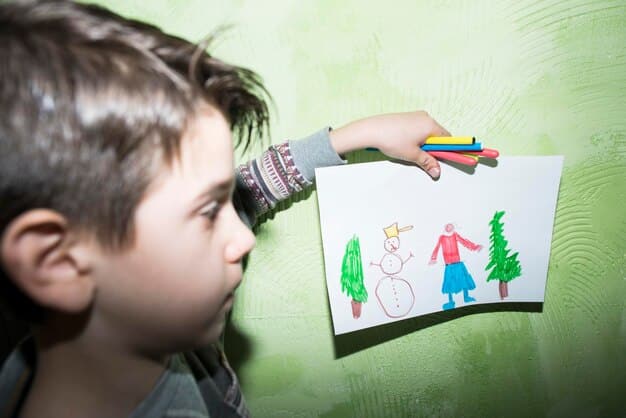Long-Term Effects of Early Childhood Trauma: A Parent’s Guide

Understanding the long-term effects of early childhood trauma is crucial for parents and educators, as early adverse experiences can profoundly shape a child’s development, impacting their emotional, cognitive, and social well-being throughout life, necessitating informed and compassionate intervention strategies.
Navigating the complexities of child development is a profound journey, and for many, a critical, yet often unseen, challenge lies in understanding the indelible marks left by early adversity. When we consider long-term effects of early childhood trauma, we delve into a sensitive but immensely important area. This guide focuses on equipping parents and educators with the knowledge to recognize, understand, and support children who have experienced early trauma, ensuring a brighter path forward.
Understanding Early Childhood Trauma: More Than Just a Bad Memory
Early childhood trauma extends beyond isolated unpleasant events; it refers to deeply distressing or disturbing experiences that occur during the formative years, typically from birth to age five. Unlike a fleeting moment of sadness, trauma involves incidents that overwhelm a child’s capacity to cope, creating lasting physiological and psychological impacts. It’s not merely about what happened, but how the child’s developing brain and body process and store those experiences.
Recognizing the nuances of trauma is vital. It’s not always overt abuse or neglect. Everyday stressors, if sustained or severe enough, can also be traumatic. This includes chronic illness, multiple caregiver changes, or even frequent exposure to domestic conflict. The impact isn’t uniform; each child’s response is shaped by their inherent resilience, the presence of supportive relationships, and the nature of the traumatic experience itself. This initial understanding forms the cornerstone of effective intervention and genuine support.
Defining Various Forms of Early Trauma
Childhood trauma manifests in diverse forms. While some are widely recognized, others are more subtle but equally damaging. Awareness of these categories helps in identifying potential issues.
- Acute Trauma: This results from a single overwhelming event, such as a serious accident, a natural disaster, or a sudden loss.
- Chronic Trauma: This involves repeated and prolonged exposure to highly stressful events, like ongoing abuse, neglect, or living in a war zone.
- Complex Trauma: This arises from exposure to multiple traumatic events, often interpersonal in nature, occurring within the caregiving system. It typically involves neglect, abuse, or abandonment.
- Developmental Trauma: A term often used to describe the impact of complex, interpersonal trauma that occurs during critical developmental periods, disrupting a child’s ability to form secure attachments and regulate emotions.
Each form leaves a unique imprint on a child’s psyche. For instance, a child experiencing acute trauma might develop specific phobias, while chronic trauma often leads to pervasive emotional regulation issues and attachment disorders. The developmental stage at which the trauma occurs also significantly influences its long-term impact, as the brain is rapidly forming new connections.
The Science Behind Trauma’s Impact on the Brain
The delicate architecture of a child’s brain is significantly influenced by early experiences. When exposed to trauma, the brain’s stress response system—primarily the amygdala, hippocampus, and prefrontal cortex—is profoundly affected. The amygdala, responsible for fear processing, may become overactive, leading to heightened anxiety and hypervigilance. The hippocampus, vital for memory and learning, can shrink, impacting cognitive function and memory recall.
Furthermore, the developing prefrontal cortex, which governs executive functions like impulse control and decision-making, may be underdeveloped, leading to difficulties in self-regulation and problem-solving. This neurobiological impact explains why the long-term effects of early childhood trauma are so pervasive, influencing not just behavior but also fundamental learning and social capabilities. Understanding these neurological changes underscores the urgency of early intervention.
At its core, understanding early childhood trauma necessitates moving beyond a simplistic view of “bad experiences.” It demands an appreciation for the intricate ways in which these experiences can reroute development, impacting a child’s fundamental sense of safety, their capacity for connection, and their ability to thrive. This comprehensive perspective is the first step towards providing truly effective support and fostering resilience in children who have faced adversity.
Emotional and Psychological Repercussions
The emotional and psychological landscape of a child who has experienced early trauma is often fraught with subtle and overt challenges. These repercussions are not transient; they tend to evolve and manifest in different ways as the child grows, influencing their self-perception, emotional regulation, and relationships with others. It’s a complex interplay of internal and external factors, with the child often struggling to vocalize their internal turmoil, making empathetic observation crucial for parents and educators.
One of the most common emotional difficulties is intense emotional dysregulation. Children may exhibit extreme mood swings, from sudden outbursts of anger to withdrawn sadness, often disproportionate to the trigger. This is a direct result of their developing stress response system being overwhelmed and subsequently wired for hyper-reactivity. They might struggle significantly with impulse control, leading to behavioral challenges in various settings.
Understanding Emotional Dysregulation
Emotional dysregulation is a significant hallmark of early childhood trauma. Children who have experienced trauma often struggle to manage their feelings effectively. This can manifest as an inability to calm themselves down after an upsetting event or an exaggerated emotional response to minor stressors. Their internal “thermostat” for emotions is often out of sync, leading to unpredictable emotional states.
- Difficulty Calming: Persistent agitation, crying, or inability to self-soothe after distress.
- Intense Mood Swings: Rapid shifts between heightened anger, deep sadness, or extreme anxiety.
- Impulse Control Issues: Acting out without considering consequences, often driven by intense emotion.
- Emotional Numbness: A detachment from feelings, appearing unresponsive or flat, as a protective mechanism.
These difficulties often stem from the dysregulation of the autonomic nervous system, which remains in a state of hyperarousal or hypoarousal. This constant state of alert or detachment makes it challenging for children to process and respond to everyday emotional cues in a healthy manner, leading to patterns of behavior that can be isolating and frustrating for both the child and their caregivers.

Impact on Attachment and Relationships
Early childhood is a critical period for forming secure attachments, which are foundational for healthy relationships throughout life. Trauma, especially when it occurs within the primary caregiving relationship (e.g., neglect, abuse), can severely disrupt this process, leading to attachment insecurity or disorganization. Children may struggle to trust caregivers, exhibit extreme clinginess, or paradoxically
avoid intimacy altogether.
This disorganized attachment often translates into difficulties in peer relationships and later romantic partnerships. They might struggle with empathy, have trouble understanding social cues, or engage in repetitive patterns of unhealthy relational dynamics. The child may, due to their traumatic experiences, perceive the world as an inherently unsafe place, leading to a constant state of vigilance or withdrawal that impedes genuine connection. Building secure attachments requires patient, consistent, and predictable care, helping the child re-learn safety and trust.
Anxiety and Depression in Traumatized Children
While often associated with adolescence or adulthood, anxiety and depression can manifest in young children who have experienced trauma. Anxiety might appear as separation anxiety, generalized worry, phobias, or compulsive behaviors. Children might express fears about safety—their own or others’—or become overly concerned with rules and routines as a way to control their environment.
Depression, in young children, often looks different from adult depression. It might manifest as persistent irritability, loss of interest in play, fatigue, changes in sleep or appetite, or a general withdrawal from social interaction. These internalizing behaviors can be easily missed or misattributed to other issues, underscoring the importance of understanding the subtle indicators associated with the long-term effects of early childhood trauma. Both anxiety and depressive symptoms can significantly impair a child’s ability to engage in learning, play, and healthy social development, highlighting the need for therapeutic intervention.
In essence, the emotional and psychological repercussions of early childhood trauma are not merely symptoms, but profound disruptions to the child’s inner world. Addressing these requires patience, empathy, and often, professional support, to help the child build new coping mechanisms and pathways towards emotional well-being and secure relationships.
Cognitive and Academic Challenges
The developing brain is a highly malleable organ, and its architecture is significantly shaped by early experiences. When trauma occurs during these critical developmental windows, it can disrupt the very pathways responsible for learning, memory, and executive functions. Consequently, children who have experienced early trauma often face considerable challenges in cognitive processing and academic performance, extending beyond simple behavioral issues. These difficulties can persist throughout their schooling and impact their ability to reach their full intellectual potential.
One primary area of concern is attention and concentration. A traumatized child’s brain is often in a state of hypervigilance, constantly scanning the environment for threats. This fundamental survival mechanism diverts cognitive resources away from learning and task focus, making it incredibly difficult to pay attention in a classroom setting. They may appear restless, easily distracted, or unable to sustain effort on academic tasks. This isn’t a deliberate defiance but a physiological response to their past experiences.
Impact on Memory and Learning
Trauma can significantly impair a child’s ability to form and retrieve memories. The hippocampus, a brain region crucial for memory consolidation, can be negatively affected by chronic stress. This translates into difficulties with both explicit memory (facts and events) and working memory (holding information temporarily to process it).
- Difficulty with Recall: Struggling to remember instructions, facts, or recently learned material.
- Impaired Working Memory: Trouble following multi-step directions or connecting new information to prior knowledge.
- Learning Gaps: Inconsistent performance due to difficulties absorbing and retaining information.
- Executive Function Deficits: Challenges with planning, organization, and problem-solving.
These memory challenges can make academic progress arduous. A child might repeatedly forget what they just learned, requiring more repetition and different teaching strategies. They may struggle with foundational skills like reading comprehension and mathematical reasoning, as these depend heavily on working memory and the ability to link concepts.
Language Development and Communication Issues
Early childhood trauma can also impede language acquisition and communication skills. Children who have experienced neglect, for instance, may have limited exposure to language-rich environments, delaying vocabulary development and complex sentence formation. Moreover, the stress response can interfere with the brain’s language processing centers, making it harder to comprehend or express thoughts verbally. Some children might become selectively mute or struggle to articulate their feelings, opting instead for behavioral expressions.
Communication can also be affected by a general distrust of adults or a fear of negative reactions. This can lead to hesitant or guarded communication, or even a reluctance to engage in conversations that require vulnerability. For educators, recognizing these communication patterns as potential signs of trauma, rather than just shyness or defiance, is key to providing appropriate support and fostering a safe space for expression.
Executive Function Deficits
The prefrontal cortex, responsible for executive functions, continues to develop well into early adulthood. Early trauma can significantly compromise its healthy maturation, leading to long-term deficits in critical cognitive skills. These skills are essential for academic success and daily functioning.
- Planning and Organization: Difficulty structuring tasks, managing time, or keeping materials organized.
- Problem-Solving: Struggling to identify solutions or adapt to new challenges.
- Impulse Control: Acting without thinking, making it hard to follow rules or respond appropriately.
- Emotional Regulation: As mentioned previously, this is deeply intertwined with executive functions, impacting behavioral responses.
These deficits can present significant hurdles in school, impacting everything from completing homework to participating in group activities. Teachers might observe a child who consistently has trouble starting or finishing assignments, despite understanding the content. Understanding these cognitive impacts of the long-term effects of early childhood trauma allows for targeted interventions and accommodations, providing the necessary scaffolding for academic and personal growth.
Ultimately, addressing the cognitive and academic challenges stemming from early trauma requires a holistic approach. It involves not only academic support but also creating a supportive, predictable, and safe learning environment that helps regulate the child’s nervous system, allowing their brain to shift from survival mode to learning mode.
Behavioral Manifestations and Social Challenges
The internal struggles of a child who has experienced early trauma frequently manifest as observable behavioral patterns and difficulties in social interactions. These behaviors are often misconstrued as intentional misbehavior, defiance, or attention-seeking, when in reality, they are often coping mechanisms or direct consequences of neurological and emotional dysregulation. For parents and educators, understanding these behavioral expressions as signs of underlying trauma is paramount to providing effective support rather than punitive responses.
One common manifestation is aggression or disruptive behavior. Children might lash out physically or verbally, display severe tantrums, or constantly challenge authority. This can stem from heightened fear responses, an inability to regulate intense emotions, or a learned pattern of reacting defensively to perceived threats. Conversely, some children may exhibit extreme withdrawal, becoming isolated, quiet, and disengaged, avoiding social interaction altogether as a form of self-protection.
Aggression, Defiance, and Hyperactivity
Children exposed to early trauma may exhibit behaviors that are often labeled as “difficult.” Their fight-or-flight response may be chronically activated, leading to a state of heightened arousal. This can manifest as:
- Aggression: Physical or verbal outbursts, hitting, biting, or throwing objects.
- Defiance: Non-compliance with rules, arguing, or testing boundaries persistently.
- Hyperactivity/Restlessness: Difficulty staying still, fidgeting, excessive talking, or constant movement.
- Impulsivity: Acting without thinking, interrupting, or difficulty waiting turns.
These behaviors are often driven by an inability to self-regulate emotions and impulses. The child may be operating from a place of fear or perceived threat, and their actions are an instinctive attempt to gain control or protect themselves. It’s crucial not to interpret these behaviors as a personal affront but as a cry for help and a sign that the child is struggling to cope with their past experiences.
Withdrawal, Passivity, and Social Isolation
On the opposite end of the behavioral spectrum, some traumatized children may become withdrawn and socially isolated. This can be a protective mechanism, where the child learns that disengaging is safer than connecting, especially if past connections have led to pain or disappointment. They might:
- Be Quiet and Reserved: Rarely initiating conversations or participating in group activities.
- Avoid Eye Contact: A sign of discomfort or distrust in social situations.
- Struggle with Peer Interactions: Difficulty making friends, maintaining friendships, or playing cooperatively.
- Exhibit Excessive Compliance: Appearing overly eager to please or highly passive, as a learned response to avoid conflict.
While less disruptive than aggressive behaviors, withdrawal is equally concerning, as it can hinder a child’s social-emotional development and lead to profound loneliness. Educators and parents need to gently encourage engagement, creating low-pressure opportunities for social interaction and building trust gradually.

Risk-Taking and Self-Harm Behaviors
As children who experienced early trauma grow, they may engage in increasingly risky behaviors, particularly in adolescence. This can include substance abuse, reckless activities, or unhealthy sexual behaviors. These actions can be an attempt to self-medicate emotional pain, to feel something (even if it’s negative), or a manifestation of a fundamental disregard for their own safety, stemming from a deeply ingrained sense of worthlessness or hopelessness.
In more severe cases, self-harm behaviors (e.g., cutting, burning) may emerge as a coping mechanism to manage overwhelming emotional pain. For these children, physical pain can sometimes feel more manageable or controllable than the intangible agony of their trauma. Recognizing these behaviors as serious warning signs, rather than just “phase,” is critical. Immediate professional intervention is necessary to ensure the child’s safety and provide therapeutic support for addressing the underlying trauma. The long-term effects of early childhood trauma often escalate without timely and appropriate intervention.
It is paramount to remember that these behavioral and social challenges are not inherent flaws in the child but rather direct consequences of their traumatic experiences. A compassionate, trauma-informed approach, focusing on safety, building relationships, and teaching coping skills, is far more effective than traditional disciplinary methods alone.
Physiological and Health Implications
Beyond the immediate psychological and behavioral impacts, early childhood trauma can leave a profound and often overlooked imprint on a child’s physical health and physiological functioning. The chronic activation of the body’s stress response system during critical developmental periods can lead to long-term changes that increase vulnerability to a range of health issues throughout life. This connection highlights the concept of “toxic stress,” where prolonged adverse experiences overwhelm a child’s ability to cope, leading to detrimental effects on bodily systems.
Children who endure trauma often experience a dysregulation of their autonomic nervous system. This means their fight-or-flight response may remain in a state of hyper-readiness, even in safe environments. This constant state of heightened alert, characterized by elevated heart rate and stress hormone production, takes a significant toll on vital organs and systems. Conversely, some children may experience a “freeze” response, where their system becomes hypo-aroused, leading to fatigue and a lack of energy.
Chronic Stress and Immune System Dysregulation
The persistent stress associated with early trauma can lead to chronic elevation of stress hormones like cortisol. While cortisol is essential for managing acute stress, prolonged high levels can suppress the immune system, making children more susceptible to illness. Research indicates a higher prevalence of:
- Frequent Infections: More colds, flu, and other common childhood illnesses.
- Autoimmune Disorders: An increased risk of conditions where the immune system attacks the body’s own tissues.
- Allergies and Asthma: A higher likelihood of developing respiratory and allergic conditions.
- Inflammatory Conditions: Increased systemic inflammation, which can contribute to various chronic diseases.
This dysregulation means that a traumatized child’s body may struggle to ward off pathogens effectively or may overreact to benign substances, leading to inflammatory responses. The immune system, designed to protect, becomes compromised, contributing to a cycle of poor health.
Sleep Disturbances and Altered Brain Chemistry
Sleep is crucial for a child’s physical and mental restoration, but it is often severely disrupted by early trauma. Children may experience nightmares, night terrors, difficulty falling asleep, or frequent awakenings. These disturbances can be attributed to the hypervigilant state of their nervous system, making it hard for them to feel safe enough to relax into deep sleep. Poor sleep, in turn, exacerbates emotional dysregulation, behavioral issues, and cognitive deficits.
Moreover, trauma can alter brain chemistry, impacting neurotransmitters like serotonin and dopamine, which are vital for mood regulation, sleep, and overall well-being. These neurobiological changes contribute to the physiological and psychological challenges observed, reinforcing the profound impact of the long-term effects of early childhood trauma on a child’s entire system.
Increased Risk for Chronic Conditions in Adulthood
Perhaps one of the most significant yet delayed physiological impacts of early childhood trauma is the increased risk for chronic health conditions in adulthood. The Adverse Childhood Experiences (ACEs) study, a landmark body of research, clearly demonstrates a strong dose-response relationship between the number of ACEs a person experiences and their likelihood of developing serious health problems later in life, including:
- Cardiovascular Disease: Higher rates of heart disease, stroke, and high blood pressure.
- Obesity and Metabolic Syndrome: Increased risk of weight gain and related conditions like type 2 diabetes.
- Chronic Pain Syndromes: Conditions like fibromyalgia and irritable bowel syndrome.
- Substance Use Disorders: As a coping mechanism for unresolved trauma.
- Mental Health Disorders: Higher prevalence of anxiety disorders, depression, and PTSD.
This link underscores that early trauma is not just a mental health concern but a significant public health issue. Understanding these physiological repercussions empowers parents, educators, and healthcare providers to advocate for comprehensive, trauma-informed care that addresses both the mental and physical well-being of affected children, aiming to mitigate these serious long-term health risks.
Guidance for Parents and Educators: Fostering Resilience and Healing
Understanding the pervasive nature of the long-term effects of early childhood trauma is a crucial first step. The more important subsequent step is providing a supportive and healing environment. Parents and educators play uniquely critical roles in fostering resilience and promoting healing for children who have experienced adversity. This requires patience, empathy, consistency, and often, a fundamental shift in perspective from traditional disciplinary approaches to trauma-informed care.
The core principle is creating a sense of safety and predictability. Children who have experienced trauma often live in a state of chronic fear or uncertainty. Establishing clear routines, consistent boundaries, and reliable presence helps to re-wire their nervous system, teaching them that the world can be a safe and predictable place. This sense of security is the foundation upon which all other therapeutic interventions and healthy development can be built. Communication, both verbal and non-verbal, should consistently convey reassurance and calm.
Creating a Safe and Predictable Environment
For a child recovering from trauma, safety transcends physical security; it encompasses emotional and psychological well-being. This requires a deliberate effort to create an environment where the child feels consistently protected and understood. Key elements include:
- Consistent Routines: Predictable daily schedules help children anticipate what comes next, reducing anxiety.
- Calm and Responsive Interactions: Adults should strive to remain calm, even when faced with challenging behaviors, responding with empathy rather than reactivity.
- Clear, Consistent Boundaries: While often perceived as restrictive, boundaries provide structure and safety, especially when consistently enforced.
- Open Communication: Encouraging children to express their feelings in a safe space, validating their emotions without judgment.
Such an environment helps the child’s brain shift from a state of hypervigilance to one where they can relax and engage in learning and growth. It’s about demonstrating, through consistent action, that the world is not always threatening.
Teaching Emotional Regulation and Coping Skills
Children affected by trauma often lack effective strategies for managing intense emotions. Parents and educators can actively teach and model these vital skills. This isn’t about suppressing feelings but about identifying, understanding, and responding to them in healthy ways.
- Emotion Identification: Helping children name their feelings (e.g., “It looks like you’re feeling frustrated”).
- Calming Techniques: Teaching deep breathing exercises, mindfulness, or sensory strategies (e.g., weighted blankets, fidget toys).
- Problem-Solving Skills: Guiding children through identifying issues and brainstorming solutions, rather than solving problems for them.
- Developing a “Coping Toolbox”: Encouraging a range of healthy activities like drawing, playing, listening to music, or talking to a trusted adult when feeling overwhelmed.
These skills empower children, giving them a sense of control over their internal experiences and reducing the likelihood of maladaptive behaviors. It’s an ongoing process that requires patience and consistent reinforcement.
Seeking Professional Support
While a supportive home and school environment are critical, professional intervention is often necessary to address the deep-seated impacts of early trauma. Therapists specializing in childhood trauma use evidence-based approaches designed to help children process their experiences and develop healthy coping mechanisms. This includes:
- Play Therapy: Using play to help children express and process traumatic experiences when verbalization is difficult.
- Trauma-Focused Cognitive Behavioral Therapy (TF-CBT): A structured approach that addresses thoughts, feelings, and behaviors related to trauma.
- Eye Movement Desensitization and Reprocessing (EMDR): Adapted for children, this therapy helps process distressing memories.
- Parent-Child Interaction Therapy (PCIT): Focuses on strengthening the parent-child relationship and teaching positive interaction skills.
Early intervention is key. The sooner a child receives appropriate therapeutic support, the better their chances of mitigating the long-term effects of early childhood trauma and fostering resilience. Parents and educators should not hesitate to seek professional guidance when challenging behaviors persist or when a child’s emotional or academic struggles seem overwhelming. Collaboration between families, schools, and mental health professionals offers the most comprehensive support system for healing.
The Role of Community and Policy in Supporting Traumatized Children
While individual efforts by parents and educators are invaluable, addressing the widespread long-term effects of early childhood trauma necessitates a broader, community-wide commitment and supportive public policy. Trauma-informed care must extend beyond the home and classroom into healthcare systems, social services, and even the justice system. A cohesive community response acknowledges that trauma is not merely an individual’s struggle but a societal challenge with far-reaching implications, demanding systemic solutions.
Communities can begin by fostering awareness and reducing stigma around trauma. This includes public education campaigns that help people understand the prevalence and impact of adverse childhood experiences (ACEs) and the importance of early intervention. When communities are more informed, they are better equipped to identify children at risk, respond with empathy, and connect families with the resources they need.
Building Trauma-Informed Systems
Shifting from a deficit-based model to a trauma-informed approach across various sectors is critical. This means training professionals in schools, healthcare, foster care, and law enforcement to:
- Recognize: Understand the signs and symptoms of trauma in children.
- Respond: Interact with traumatized individuals in a way that avoids re-traumatization.
- Resist Re-traumatization: Design policies and procedures that promote safety, trust, collaboration, and empowerment.
- Refer: Connect families to appropriate mental health and support services.
For example, a trauma-informed school might focus on restorative justice practices instead of traditional punitive discipline, recognizing that disruptive behavior often stems from underlying trauma. A healthcare provider might routinely screen for ACEs and offer resources rather than just treating physical symptoms in isolation. These systemic shifts create a safety net for children and families, providing pathways to healing rather than perpetuating cycles of harm.
Early Identification and Prevention Programs
Proactive approaches are essential in mitigating the pervasive effects of trauma. This involves implementing robust early identification programs within pediatric clinics, preschools, and social service agencies. Regular screening for risk factors and early signs of trauma allows for timely intervention, potentially preventing deeper, more entrenched long-term effects of early childhood trauma.
Furthermore, investing in prevention programs is paramount. This includes initiatives that support new parents, provide home visiting services, offer quality early childhood education, and address systemic issues like poverty and community violence. By strengthening protective factors in a child’s life and reducing exposure to adversity, communities can dramatically lower the incidence of early childhood trauma. This societal commitment to nurturing environments for all children strengthens the fabric of the community as a whole.
Advocacy for Policy Changes
Ultimately, lasting change requires policy shifts at local, state, and national levels. This involves advocating for legislation that:
- Increases funding for mental health services for children.
- Supports trauma-informed training for professionals across sectors.
- Invests in early childhood development programs and family support initiatives.
- Addresses root causes of trauma, such as poverty, housing insecurity, and systemic inequities.
These policy changes are not just humanitarian; they are economic imperatives. The long-term societal costs associated with untreated childhood trauma—in healthcare, education, and the justice system—far outweigh the investment in early prevention and intervention. By prioritizing policies that foster resilience and healing, society can create a future where every child has the opportunity to thrive, free from the enduring shadow of early adversity.
| Key Impact | Brief Description |
|---|---|
| 🧠 Brain Changes | Trauma alters brain development, affecting memory, learning, and emotional regulation. |
| 💔 Emotional Struggles | Leads to dysregulation, anxiety, depression, and difficulties forming secure attachments. |
| 📚 Academic Challenges | Impacts attention, memory, executive function, leading to cognitive and learning difficulties. |
| 🩺 Health Risks | Increases susceptibility to chronic physical health conditions, e.g., autoimmune disorders. |
Frequently Asked Questions About Early Childhood Trauma
Early childhood trauma can significantly alter brain development, particularly impacting the amygdala (fear processing), hippocampus (memory), and prefrontal cortex (executive functions). This can lead to an overactive stress response, impaired memory and learning, and difficulties with impulse control and emotional regulation throughout their lives, underscoring the long-term effects of these early experiences.
Common behavioral signs include aggression, defiance, hyperactivity, or, conversely, withdrawal and social isolation. Children might also struggle with impulse control, exhibit intense mood swings, or engage in risk-taking behaviors. These are often coping mechanisms or direct results of their dysregulated nervous system, not intentional misbehavior, and require compassionate understanding.
Yes, prolonged exposure to toxic stress from early trauma can lead to chronic physiological changes. This increases the risk for various physical health issues in adulthood, including cardiovascular disease, obesity, autoimmune disorders, and chronic pain, highlighting the profound mind-body connection and the extensive long-term impact of early adversity on physical well-being.
Parents and educators can best support these children by creating a safe, predictable, and consistent environment. This includes establishing routines, modeling calm responses, teaching emotional regulation skills, and setting clear, consistent boundaries. Seeking professional therapeutic support tailored to childhood trauma is also crucial for their healing journey and development.
While trauma can leave lasting imprints, children possess remarkable resilience. With consistent, loving, and trauma-informed support, professional intervention, and a safe environment, children can learn to process their experiences, develop healthy coping mechanisms, and thrive. Full “recovery” means achieving functional well-being and a fulfilling life, rather than erasing past events.
Conclusion: Nurturing Hope and Healing
The journey of understanding and addressing the long-term effects of early childhood trauma is complex, yet profoundly vital. It is a testament to the remarkable malleability of the human spirit and brain when given the right support. While the impact of early adversity can be far-reaching, leading to challenges in emotional regulation, cognitive functioning, social relationships, and even physical health, it is equally important to emphasize that healing and resilience are profoundly possible. For parents and educators, this knowledge empowers a shift from reactive responses to proactive, compassionate, and trauma-informed care. By prioritizing safety, nurturing secure attachments, teaching coping skills, and advocating for systemic support, we can collectively create environments where every child, regardless of their past, has the opportunity to thrive, learn, and grow into their full potential. The commitment to fostering healing in our youngest generations is an investment not just in individual lives, but in the collective well-being of our future.





